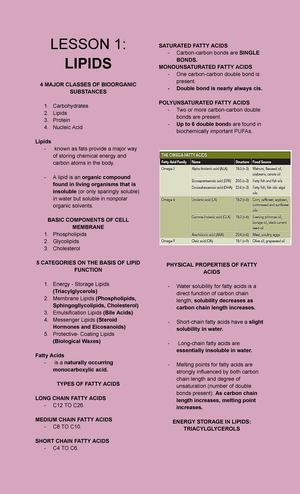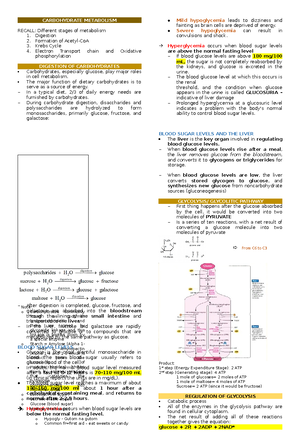- Information
- AI Chat
Was this document helpful?
Carbohydrate Digestion and Absorption
Course: BIOCHEMISTRY (CHM3)
365 Documents
Students shared 365 documents in this course
University: Our Lady of Fatima University
Was this document helpful?

CARBOHYDRATES
● Most abundant biomolecule
● Polyhydroxy ketone or aldehyde
● Contains CHO
● May be branched or unbranched
● Can be mono, di, oligo, and poly
● Monosaccharides
○ Glucose
○ Galactose
○ Fructose
○ Ribose
●Disaccharides (MCLS)
○ Maltose
○ Cellobiose
○ Lactose
○ Sucrose
●Polysaccharides (Storage, Structure, Acidic)
○2 forms: homopolysaccharides (all except acidic), heteropolysaccharides
(acidic)
○Storage: starch (plants), glycogen (animals)
○Structural: cellulose, chitin
○Acidic: hyaluronic acid (lubricants in fluids of joints), heparin (blood
anticoagulant)
DIGESTION AND ABSORPTION OF CARBOHYDRATES
- Magkakaiba ang process of digestion and formation of acetyl coA ng carbohydrates,
lipids, and proteins
Digestion - the biochemical process by which food molecules, through hydrolysis, are
broken down into simpler chemical units that can be used by cells for their metabolic needs.
● Mouth
○Physical: mastication (chewing of food) through teeth
○Chemical: due to the presence of saliva which contains salivary a-amylase
● Pharynx
○ Common passageway of food and air (pupunta sa trachea)
● Epiglottis
○ Separates the pharynx and the esophagus
● Esophagus
○ Passageway of food
○ Circular layers inside, longitudinal layers outside
● Gastroesophageal sphincter
● Stomach
○ Salivary a-amylase will deactivate because of the acidic nature of the
stomach
○Physical Digestion: peristaltic movement grinds the food





